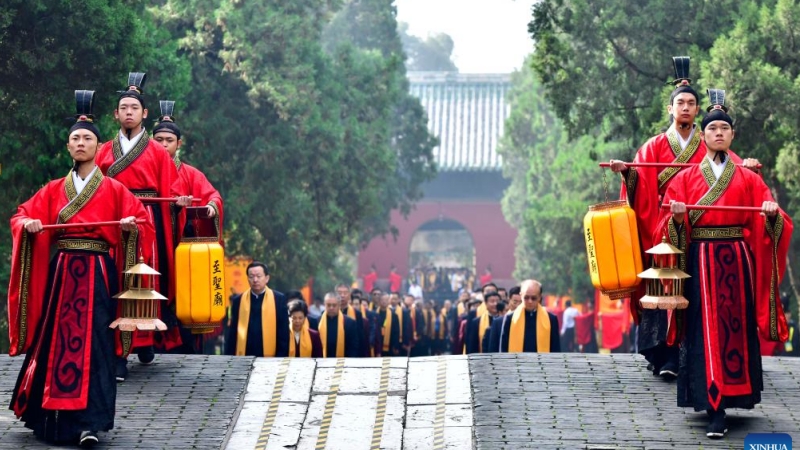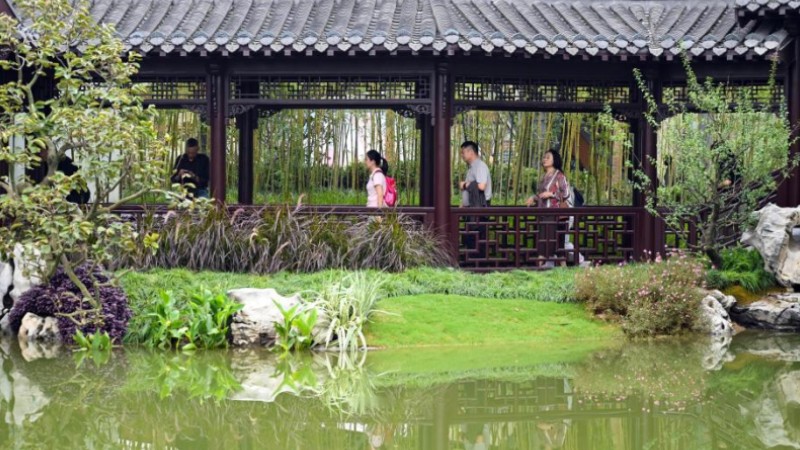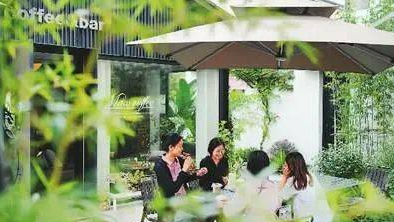Centuries-old tea road regains glory as Belt and Road cooperation deepens
* A lengthy tea road linking the tea-growing region of the Wuyi Mountains to the Russian port city of St. Petersburg thus came into being with the help of these merchant guilds, who brought the aroma of the time-honored tea culture overseas and bore witness to an enduring bond between people along the route.
* Several centuries ago, tea was introduced to Russia and gained traction. Russians loved tea so much that they developed their own unique tea drinking culture.
FUZHOU/ST. PETERSBURG, Oct. 2 (Xinhua) -- Nestled in the picturesque Wuyi Mountains in southeast China's Fujian Province is a tranquil village named Xiamei, one with a rich past and profound culture.
The millennia-old village was once a bustling logistics hub and the starting point of an ancient tea road stretching about 13,000 km all the way to St. Petersburg, Russia, during the Qing Dynasty.
Today, after more than a century of dereliction, the tea road starting from here is regaining its former importance as China, Russia and Mongolia join forces for closer cooperation under the Belt and Road Initiative (BRI) and as people rediscover the historical and cultural significance of this trade artery.
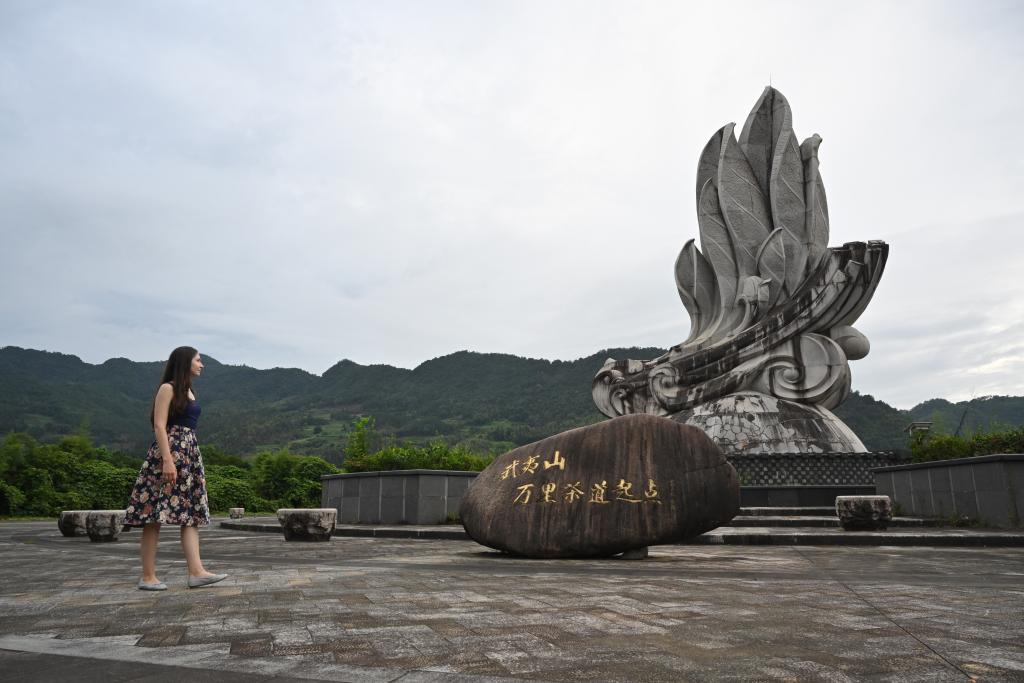
A Xinhua correspondent of Russian nationality visits a sculpture located at the starting point of an ancient tea road in Xiamei Village, Wuyishan City, southeast China's Fujian Province, Sept. 5, 2023. (Xinhua/Jiang Kehong)
A CLOSER BOND
Xiamei thrived from the end of the 17th century due to a growing demand in the Russian market for Chinese tea and the booming China-Russia tea trade made possible through Jin (short for Shanxi Province) merchants, who rose to prominence during the Ming and Qing dynasties.
A lengthy tea road linking the tea-growing region of the Wuyi Mountains to the Russian port city of St. Petersburg thus came into being with the help of these merchant guilds, who brought the aroma of the time-honored tea culture overseas and bore witness to an enduring bond between people along the route.
For starters, this was a tea road connecting not only China and Russia, but the north and south of China, with varying natural endowments and comparative strengths.
As a major tea-growing base and the earliest tea exporter along the road, the Wuyi Mountains boasts a suitable climate for tea growing, rich tea resources as well as fine tea traditions and techniques. Tea leaves harvested from here could be well-preserved under the drier climate in the north, as they were shipped north for sale in Russia and other European countries, a process which overall took about a year. The taste and quality of tea transported overland via the tea road was more favored than tea imported by sea.
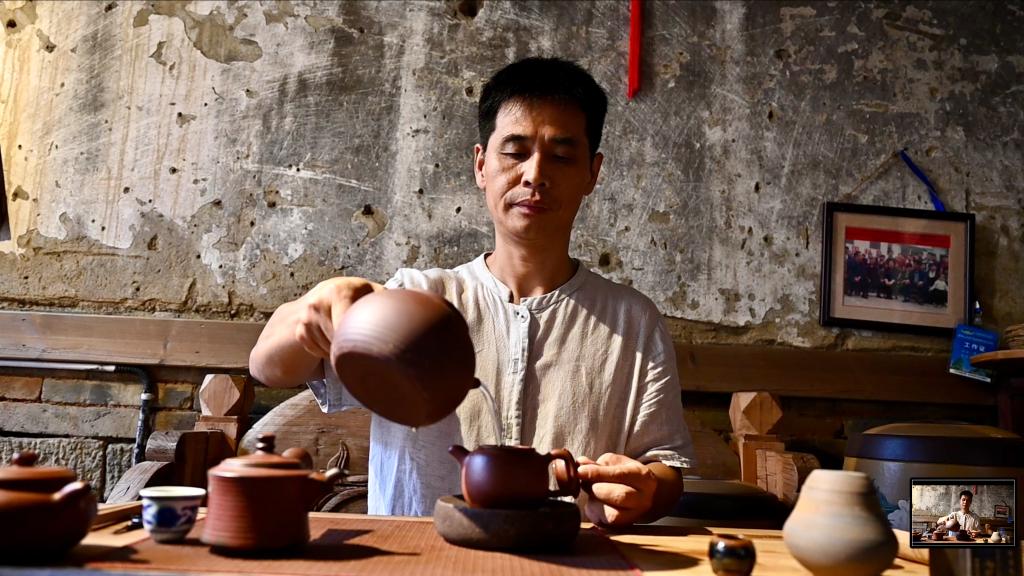
Zou Yingwen, an inheritor of Wuyi Mountains tea-making techniques, makes tea in Xiamei Village, Wuyishan City, southeast China's Fujian Province, Sept. 5, 2023. (Xinhua/Jiang Kehong)
Zou Yingwen, who is carrying on Wuyi Mountains tea-making techniques, told Xinhua that for more than a century, Jin merchants have partnered with Xiamei businessmen in tea selection, processing and transportation, managing a profitable tea business. The brick tea and black tea were shipped north to Zhangjiakou, Hebei Province and then carried by camel caravans to Kyakhta, a border town in Russia designated for tea trade, before they hit the markets in Moscow, St. Petersburg, and elsewhere in Europe.
During Emperor Xianfeng's reign (from 1850-1861) in the Qing Dynasty, the southern tea road was blocked, so Jin merchants shifted their focus to central China's Anhua, Hunan Province and Yangloudong, Hubei Province, where tea was processed into brick tea before being shipped to Hankou by water and transferred north overland. Today, in the ancient streets in Yangloudong, the ruts of wheelbarrows that once transported tea are still clearly visible.
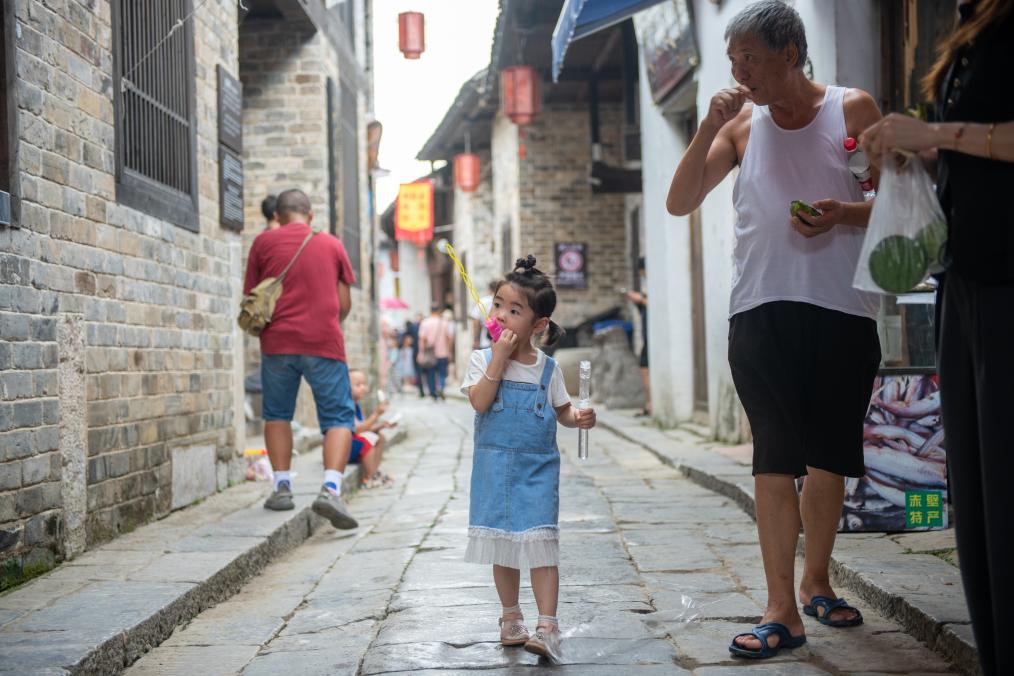
Tourists visit an ancient street in Yangloudong of Chibi City, central China's Hubei Province, Sept. 9, 2023. (Photo by Du Zixuan/Xinhua)
The special processing technique of making brick tea allows tea to be preserved over a long period of time, and the taste of aged brick tea gets more intense and pure with the passage of time, said Quan Wei, who specializes in dark tea-making techniques.
In the mid-19th century, Russian traders flocked to central China's commercial port of Hankou to engage in tea business. They initially set up tea mills in Yangloudong to process brick tea locally before they moved to Hankou, where they made brick tea with steam engines and hydraulic presses for the Russian market.
After that, Hankou tea exports boomed, accounting for more than 60 percent of China's total tea export by the end of the 19th century. With its key role in the tea trade, Hankou became a veritable "Oriental Tea Port."
Today in Hankou District, Wuhan City, sculptures and Russian-style architecture built by former tea traders bear witness to the flourishing China-Russia tea trade.
With the extension of the tea road for camel caravans, towns and cities sprung up in the wilderness. This trade road extended beyond tea and other goods, but also enabled people from different civilizations to meet.
A TIME-HONORED CUSTOM
Several centuries ago, tea was introduced to Russia and gained traction. Russians loved tea so much that they developed their own unique tea drinking culture. In the 18th century, Russians invented the samovar, which was used for brewing tea. Today, drinking tea with snacks and desserts is still a favored way for Russians to socialize.
Renowned Russian poet Alexander Pushkin wrote in his epic Eugene Onegin, "Day faded; on the table, glowing, the samovar of evening boiled, and warmed the Chinese teapot; flowing beneath it, vapour wreathed and coiled." Throughout his life, Pushkin made frequent references to the immutable importance of tea in Russian culture.
To meet Russians' demand for tea, places such as Moscow and St. Petersburg once opened numerous tea houses. The Russian government even granted tax incentives to tea houses countrywide to encourage tea drinking as an alternative to alcohol.

Two Russian ladies enjoy tea at home in St. Petersburg, Russia, Sept. 25, 2023. (Photo by Irina Motina/Xinhua)
Sergey Kalashnikov, chairman of the Russian Association for International Cooperation, said Chinese tea has had a huge impact on the life and culture of Russians, partly replacing kvass, beer and home-brewed alcohol, and the custom of tea drinking is deeply rooted in Russian culture. "Tea has actually become a national drink in Russia," Kalashnikov said.
In Siberia and the Mongolian plateau, tea refreshes herdsmen and helps with digestion, and is hence an indispensable drink. Drinking salty milk tea made from brick tea has long been a custom of Mongolians.
These traditions wouldn't have emerged without China's Jin merchants. Though Shanxi Province is not the hometown of tea, it is the hometown of a group of prominent merchants who have promoted tea drinking and dominated the tea road for more than 200 years. Many of their businesses or tea houses even had branches in Moscow and other Russian cities. Their history of tea-making and selling is also well documented.

This photo taken on Aug. 30, 2023 shows a view of the Qu family compound, the historical residence of one of China's most prominent Jin merchant families during the Ming and Qing dynasties, in Qixian County, north China's Shanxi Province. (Xinhua/Zhan Yan)
Tian Jian, director of the Jin Merchants Research Institute in Qi County, Shanxi Province, described the Jin merchants as a group of "honest, trusty, pioneering, pragmatic, cooperative and benevolent merchants" who blazed the trail of the tea road and promoted trade based on the principles of "connectivity, harmony and win-win."
A REVITALIZED ROAD
Over the past 250 years, merchants along the route have continuously traded furs and tea, paving an important trade road for a flourishing Eurasia. China-Russia trade centered around tea has boosted tea planting and logistics, and spurred socio-economic growth in China's northern steppe and Russia's Siberia region.
However, by the end of the 19th century and the beginning of the 20th century, the tea road lost its former glory and was gradually forgotten due to war, the rise of railway and sea transportation, and the shrinking demand for Chinese tea.
Today, deeper cooperation via the BRI is revitalizing this old trade road, as China, Russia and Mongolia further tap into the potential of their economic and cultural links through this existing channel.

Visitors taste tea at a tea industry expo held in Moscow, Russia, July 14, 2023. (Photo by Alexander Zemlianichenko Jr/Xinhua)
Over the past decade, China, Russia and Mongolia have worked together to restore global recognition of the significant tea road as a cultural heritage. In March 2019, the State Administration of Cultural Heritage included the Tea Road in the Preparatory List of China's World Cultural Heritage, officially elevating its application to the national level.
Huang Baiquan, dean of the School of History and Culture of Hubei University, believed that the three countries' joint application of the tea road in the world heritage list is "of great significance for enhancing their traditional friendship and political mutual trust and promoting the construction of the China-Mongolia-Russia economic corridor."
As an important component of the China-proposed BRI, the trilateral economic corridor has been regarded by many as "a modern version" of the ancient tea road, promising innumerable economic opportunities for landlocked regions like Mongolia.
The ancient tea road now boasts developed air, road and railway transportation networks, serving once again as a road to common prosperity, as it witnesses ever closer economic and trade cooperation as well as personnel exchanges.
As a big tea consumer, Russia's import for Chinese tea is growing, largely facilitated with the China-Europe freight trains. In August 2022, Hubei Province's first tea export train carrying about 1,000 tons of black tea left Wuhan and arrived in Moscow in just 20 days.
During the COVID-19 pandemic, Mongolia donated 30,000 sheep to China to support its fight against the coronavirus and China's Hubei Province returned the goodwill with the Mongolian people's much-loved brick tea. Tea brought back their shared cultural memories from centuries ago.
Kalashnikov compared the tea road to the cultural veins of the Belt and Road. "For centuries, the tea road has been an economic and cultural bridge connecting China, Russia and Europe, and it still plays a special role in people-to-people friendship," he said.
Photos
Related Stories
- Infographics: Beauty along the Belt and Road
- BRI bears rich fruits in economic, trade cooperation over past decade
- Building Belt and Road for win-win development Episode 5: BRI livelihood projects bringing benefits to all
- Building Belt and Road for win-win development Episode 4: Sustainable development making growth greener
- Building Belt and Road for win-win development Episode 6: Forging a closer people-to-people bond through mutual learning among civilizations
- Building Belt and Road for win-win development Episode 3: Intelligent development leading to new opportunities
Copyright © 2023 People's Daily Online. All Rights Reserved.






